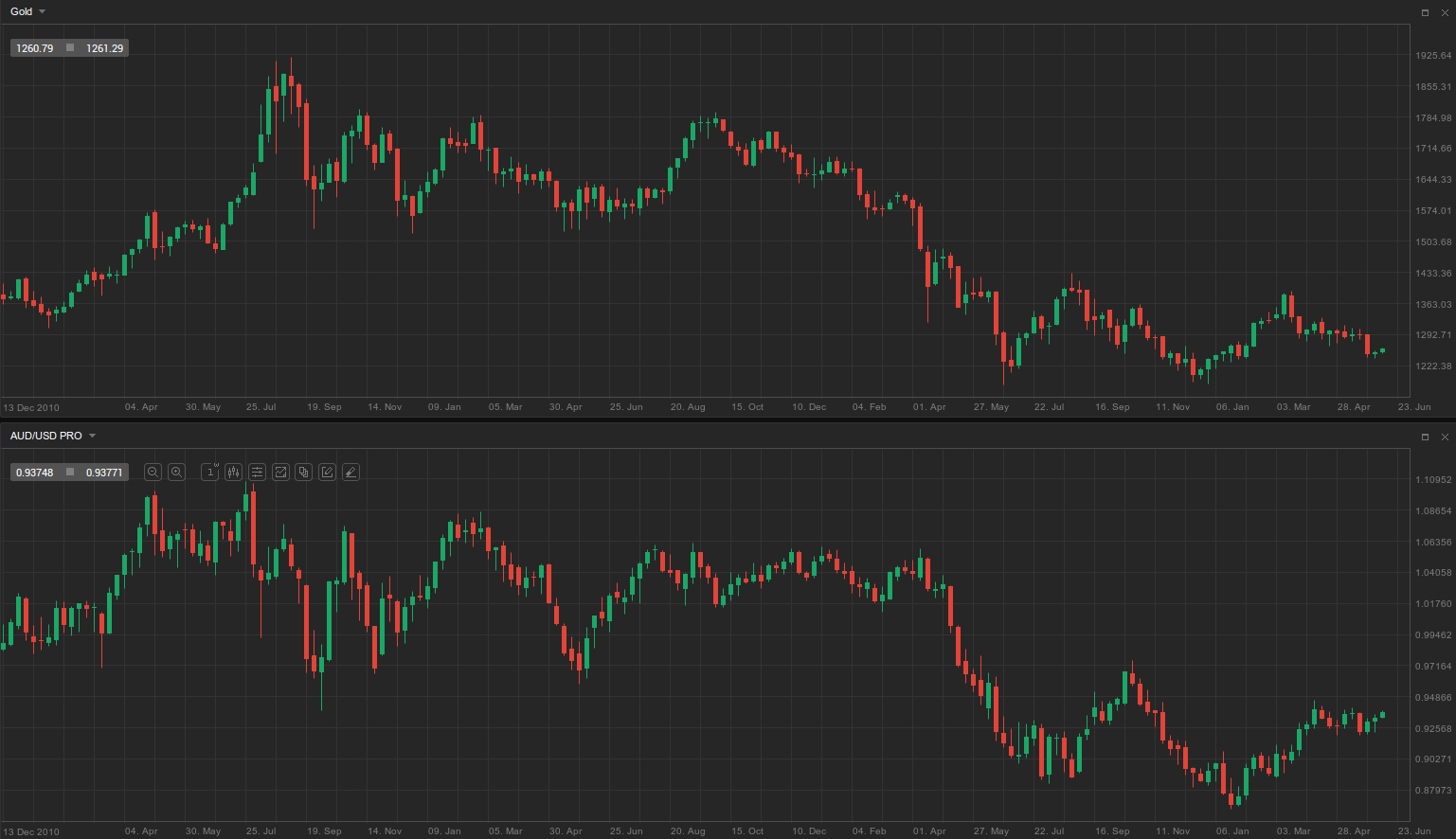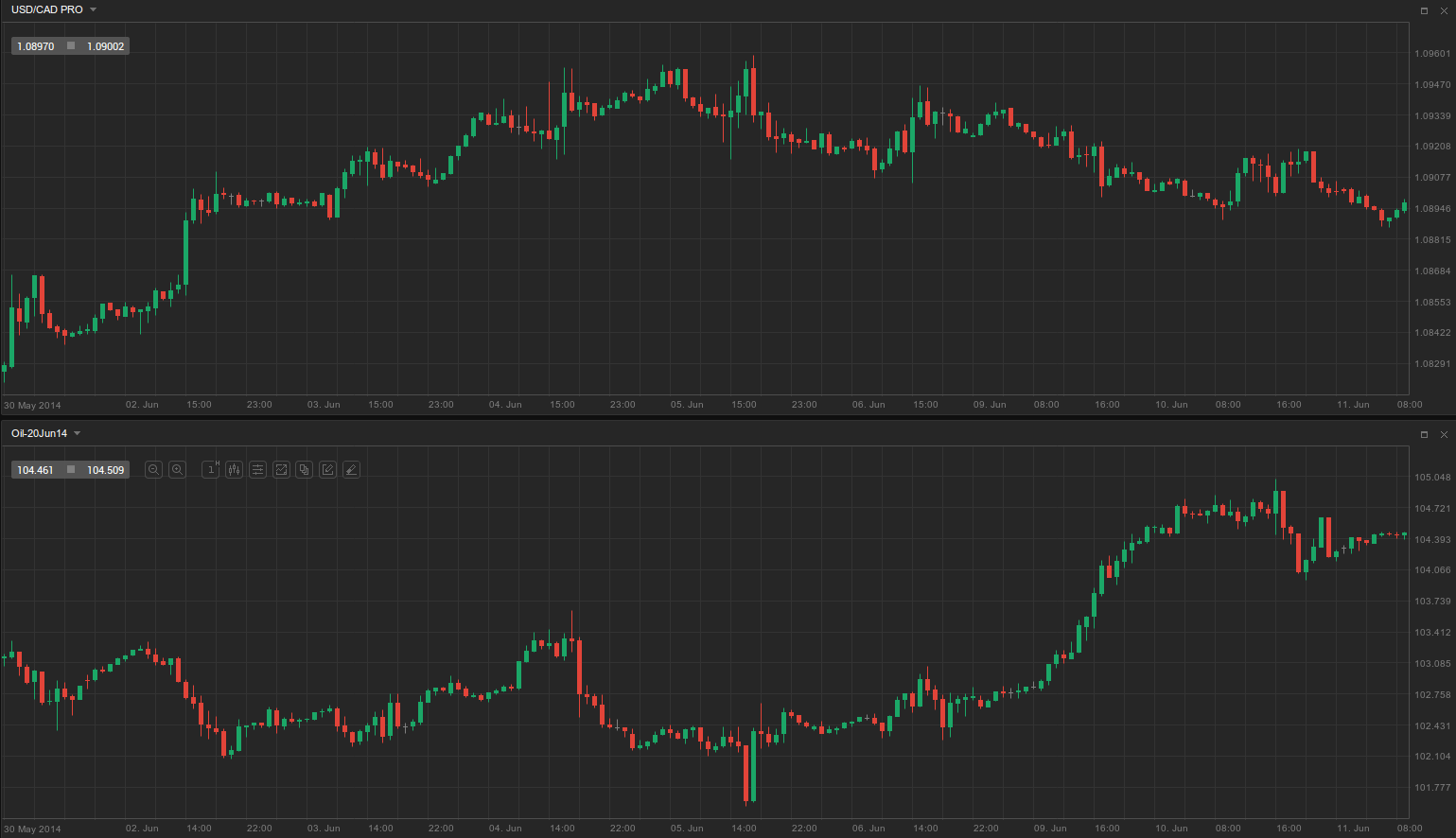Positioning according to changes in commodity prices
This lesson will cover the following
- General thoughts on commodities trading
- Gold correlation to commodity-based currencies
- Oil correlation
As we have mentioned in the Major Currency Profile section of our day-trading guide, there is a very strong correlation between certain commodities and a number of currencies, which is why they are known as ‘commodity-based’ currencies. These are the Australian dollar, the New Zealand dollar, the Canadian dollar and the Swiss franc.
We have already discussed that the Australian, New Zealand and Canadian dollars are strongly correlated to commodity prices because of their economies’ heavy reliance on exports of raw materials (especially the CAD’s relationship to oil) and the close ties between New Zealand and Australia. All three have solid correlations with gold prices, while the Swiss franc is historically tied to the precious metal because of a past constitutional requirement stating that 40% of the national currency should be backed by gold. Although that requirement has been removed, the connection between gold and the franc remains rooted in Swiss investors’ mindset.
Even though we haven’t spoken much about commodities trading, it will suffice for now to say that they are also priced according to the supply-demand principle. However, different raw materials are influenced by varying factors that affect their supply and demand. For example, wheat prices can surge if weather agencies predict unfavourable conditions in Ukraine, Australia or any other major producer. At the same time, if a country bans the import of a certain strain of wheat, for example, produced in the US, this would have a negative impact on US wheat prices as demand for US shipments declines and stockpiles rise. There are many peculiarities in commodity trading, but in general oil and gold’s price movements are fuelled by similar fundamental factors to those that drive currencies.
- Trade Forex
- Trade Crypto
- Trade Stocks
- Regulation: NFA
- Leverage: Day Margin
- Min Deposit: $100
Greenback relation
The strong correlation between gold and those four currencies is also based on the US dollar’s inverse relationship with the precious metal. Although the US is the world’s third-biggest producer of gold, rising gold prices do not increase the value of the greenback; quite the opposite. This is due to the yellow metal’s status as a safe haven, which investors seek during times of economic and political uncertainty as they move away from the greenback. Conversely, during times of economic prosperity the dollar appreciates as investors’ risk appetite draws their capital out of gold and into riskier assets. This is why gold is referred to as the ‘anti-dollar’. So, as the greenback declines and gold rises, AUD/USD and NZD/USD tend to mirror the metal’s movement, while USD/CHF moves in the opposite direction.
But, as we said, there is more to it. In 2013, Australia was the world’s second-largest producer of gold at a little over 250 metric tonnes, while Canada ranked seventh with an output of around 120 tonnes. Based on the substantial value of gold exports and also the inverse relationship of the metal to the US dollar, the AUD/USD cross has a very strong positive correlation with gold (close to 0.8).
Rising gold prices have two implications for the pair – first, if gold is gaining on the back of economic uncertainty, the US dollar has likely already begun to fall, so AUD/USD should be on the rise. Second, higher gold prices will force importers of Australian gold to purchase more Australian dollars in order to pay for the metal, and the increased demand will further appreciate the AUD. It is also worth noting that the Australian dollar can be used in carry trades, which we discussed in the article ‘Carry Trades’. This means that when gold and AUD/USD go up, many traders prefer to invest in the currency pair instead of the metal, as both express the same view of market conditions, but the Australian dollar can yield additional return through the carry trade. In the screenshot below you can observe the positive correlation between the Australian dollar and gold.

The same principle applies to the Canadian dollar, and it has approximately the same correlation with gold. As for the NZD, although New Zealand is not a major gold producer and ranked 25th in 2006 with an annual output of a little over 10 metric tonnes, its close ties to the Australian economy are behind the NZD/USD pair’s positive correlation with gold.
Among the four commodity-based currencies, the Swiss franc has the strongest correlation with gold (close to 0.9). However, the positive relationship is of a different nature, because Switzerland is not a gold producer and, unlike New Zealand, its economy is not closely linked to any major gold exporter. The reason is the Swiss franc’s historical connection with gold. Under a legal requirement, which was removed via a referendum on 1 May 2000, 40% of the Swiss currency had to be backed by gold reserves. Regardless, the Swiss franc’s status as a premier safe-haven currency has retained its strong positive relationship with gold, largely abetted by the country’s political neutrality and confidential banking system, which attract foreign capital during times of political and economic turmoil.
Oil correlation
Due to the global economy’s reliance on oil and its sensitivity to major price shifts, there are very complex and varied correlations between oil and currency pairs. Of the four commodity-based currencies, only the Canadian dollar has a more stable and pronounced relationship with this raw material’s price, and here is why.
Canada was the world’s fifth-biggest oil producer in 2012, with an output of 3.856 million barrels per day, trailing only Saudi Arabia, the United States, Russia and China. Canada’s most-exported product is crude petroleum, while refined petroleum ranks third and petroleum gas fifth, accounting for 16%, 4.1% and 3.7% of total outbound shipments, respectively. Thus, poor economic conditions among its trading partners, especially the US, will drive demand for oil down and therefore have a negative impact on the Canadian dollar, and vice versa. At the same time, the cold Canadian climate spurs demand for heating oil throughout the year. In the screenshot below you can see the correlation.

Having acquainted you with the connection between gold, oil and commodity-based currencies, you can understand why many traders use raw material prices as leading indicators for currency movements. As we mentioned earlier, expressing their view on commodities through currencies also allows them to benefit from interest-rate differentials (carry trades), which many traders aim for. This is clearly visible in the two examples provided above. Some traders also use other commodities as leading indicators, similar to the relationships between gold, oil and currencies, which helps diversify risk.
